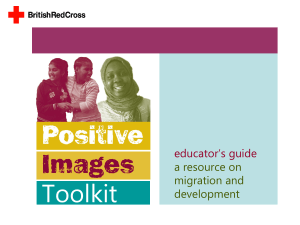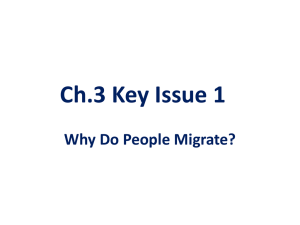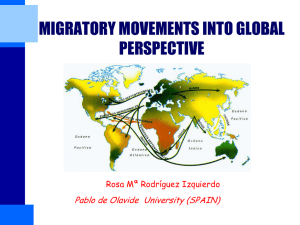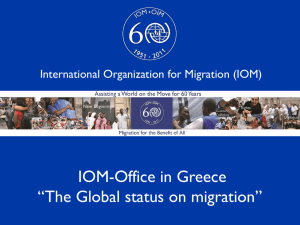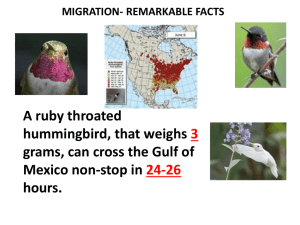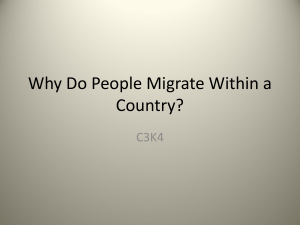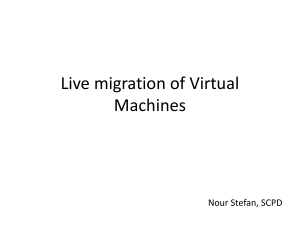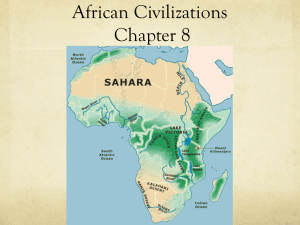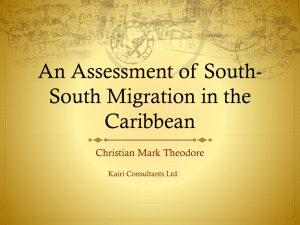Chapter 3 Migration - Erie City School District
advertisement
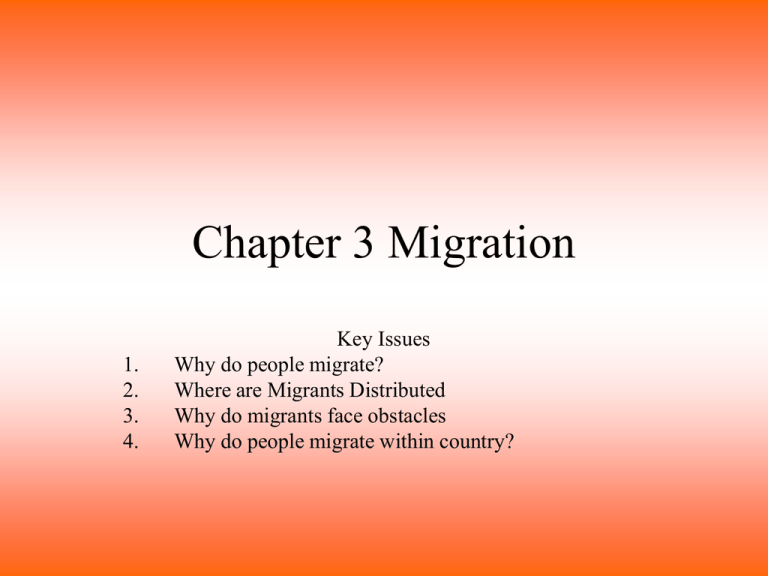
Chapter 3 Migration 1. 2. 3. 4. Key Issues Why do people migrate? Where are Migrants Distributed Why do migrants face obstacles Why do people migrate within country? • Read the Introduction Why do people migrate? • • • • Migration- a permanent move to a new location. Emigration- migration from a location. Immigration- migration to a location Net migration- difference between emigration and immigration. If emigration is higher, than it is net out-migration. If immigration is higher, than it is net in-migration. • Mobility- general term concerning all types of movement from place to place. • Circulation- the day-to-day movement/route of a person. Most people migrate for economic purposes, others for cultural and/or environmental reasons, according to E.G. Ravenstein’s migration “laws.” Migration has been tremendously enhanced in the past century due to various types of transportation. – What are these new various forms of transportation? • Push factor- a force that induces people to move out of their present location. • Pull factor- a force that induces people to move into a new location. 3 types of push and pull factors are: – -economic: more jobs, better pay, etc. – -cultural: forced migration because of political unrest or slavery. – Refugee- a people forced to migrate from their homes and not allowed to return for fear of persecution. – environmental: harsh conditions tend to push people, i.e. floodplain- area around a river prone to flooding. conditions tend to pull people, i.e. Florida. Appealing • What caused you to take this class or move here? • Intervening obstacle- an environmental or cultural feature that hinders migration, such as the Rocky Mountains, Atlantic Ocean, etc. • Ravenstein’s laws outline two points about migration distances: 1. -Most migrants relocate a short distance and remain w/in the same country. 2. -Long-distance migrants to other countries head for major centers of economic activity. • International migration- permanent move from one country to another. • Voluntary migration- migrant chooses to move for economic or environmental reasons. • Forced migration- migrant is compelled to move due to cultural pressures. • Internal migration- permanent move w/in the same country. • Interregional migration- move from one region to another w/in country. – Intraregional migration- move w/in one region w/in one country • Migration transition- identified by Wilbur Zelinsky, it consists of changes in a society comparable to the demographic transition. – Stage 1 consists of little migration; – Stage 2 involves international migration; – Stages 3 and 4 are characterized by internal migration. • Ravenstein claimed that migrants have typical characteristics: -Most long-distance migrants are male. -Most long-distance migrants are adults rather than families with children. Why?? • In recent years, these trends have softened somewhat and the numbers now show a more 50-50 split in the gender of migrants. The family status of migrants has remained largely the same though. Key Issue 2: Where are Migrants Distributed? US MIGRATION PATTERNS • The US experienced 3 main migratory periods: -Initial settlement of colonies from Europe and Africa -Mid-19th century to early 20th. First from N. and West Europe, later from S. and East Europe. -1970s to today. Mainly from LDC’s, such as Mexico, China, India, etc. • Undocumented immigrants- individuals who enter the U.S. without proper documents. – 3 million Mexico, 300000 El Salvador, 100000 Canada, – More then half come on Visas and then refuse to leave • Why is this a problem? • More than one-half the immigrants to the U.S. are clustered in 4 states, California, New York, Florida, and Texas. • Chain migration- the migration of people to a specific location because relatives or members of the same nationality previously migrated there. Discussion Questions • Out of the three types of migration, which has effected American s the most and why? – Give an example of each migration within the U.S. and how it effected the cultural landscape • According to Zelinsky’s model, which stage of the migration model do you believe we are in today? Why do migrants face obstacles? • Quotas- maximum limits on the number of people who could immigrate to the U.S. from a country in 1 year. • Brain drain- the large-scale emigration of talented or scholarly individuals. • Guest workers- citizens of poor countries who temporarily obtain dangerous lowpaying jobs in MDC’s that the permanent citizens refuse to accept. (similar to time-contract workers) • There is often difficulty distinguishing betwixt economic migrants and refugees, especially during times of large-scale conflict. Ex. Cuba, Vietnam, Haiti. • Often immigrants to the U.S. and W. Europe face racism or prejudice from the permanent residents who see the migrants as economic competition, cultural oddities, etc. Why do people migrate within a country? • movement West- For nearly 200 years, the dominant movement of American people was almost due west in the search for new farmland to satisfy an overwhelmingly agrarian society, causing the population center to continue its march westward into the country. • In recent years, migration between regions has been dominated by the search for better jobs, not different land to perform the same job on. Also, environmental factors have played a large part, i.e. old people moving to Florida. – Like Coach Serina from Ohio • In other countries, interregional migration has been prompted for a variety of reasons. – Some like in Russia, Brazil, or Indonesia were either forced or encouraged by the government to move in order to develop certain areas of the country. • We do this in the U.S. too, more money for different areas and jobs • Migration within a region of a country – In LDC’s, the migration trend recently has been ruralurban. – In MDC’s, the migration trend has been urbansuburban • Counterurbanization- net migration from urban to rural areas. – This has been a trend in MDC’s, as improved technologies enable people to live farther from their places of employment and still enjoy all the amenities the city offers. – However, in the U.S., counterurbanization has stopped because of poor economic conditions in the rural.

